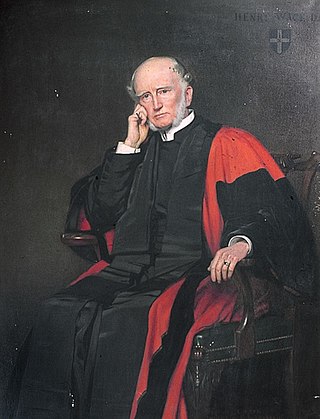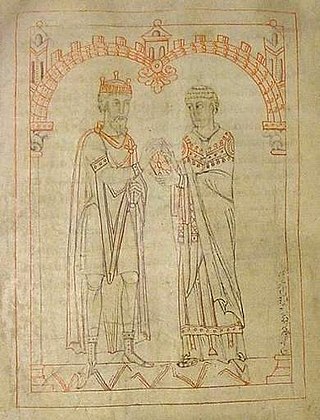Related Research Articles

Anatolius was a Patriarch of Constantinople. He is regarded as a saint, by both the Orthodox and Roman Catholic Churches.

Henry Wace was an English Anglican priest and ecclesiastical historian who served as Principal of King's College, London, from 1883 to 1897 and as Dean of Canterbury from 1903 to 1924. He is described in the Dictionary of National Biography as "an effective administrator, a Protestant churchman of deep scholarship, and a stout champion of the Reformation settlement".
Domnus II was the Patriarch of Antioch between 442 and 449 and a friend of the influential Bishop of Cyrrhus, Saint Theodoret.

The Alogi (ἄλογοι), also called Alogoi or Alogians, were a group of heterodox Christians in Asia Minor that flourished c. 200 CE, and taught that the Gospel of John and the Apocalypse of John were not the work of the Apostle, but his adversary Cerinthus. What we know of them is derived from their doctrinal opponents, whose literature is extant, particularly St. Epiphanius of Salamis. It was Epiphanius who coined the name "Alogi" as a word play suggesting that they were both illogical (anti-logikos) and they were against the Christian doctrine of the Logos. While Epiphanius does not specifically indicate the name of its founder, Dionysius Bar-Salibi, citing a lost work of Hippolytus, writes in his commentary on the Apocalypse,
Hippolytus the Roman says: A man appeared, named Caius, saying that the Gospel is not by John, nor the Apocalypse but that it is by Cerinthus the heretic.
Epiphanius Scholasticus was a sixth-century translator of Greek works into Latin.
Sabellius was a third-century priest and theologian who most likely taught in Rome, but may have been a North African from Libya. Basil and others call him a Libyan from Pentapolis, but this seems to rest on the fact that Pentapolis was a place where the teachings of Sabellius thrived, according to Dionysius of Alexandria, c. 260. What is known of Sabellius is drawn mostly from the polemical writings of his opponents.

Eucherius was a high-born and high-ranking ecclesiastic in the Christian church in Roman Gaul. He is remembered for his letters advocating extreme self-abnegation. From 439, he served as Archbishop of Lyon, and Henry Wace ranked him "the most distinguished occupant of that see" after Irenaeus. He is venerated as a saint within the Catholic Church.
Marius Aventicensis or, popularly, Marius of Avenches was the Bishop of Aventicum from 574, remembered for his terse chronicle. After his death in Lausanne, he was venerated in that city as a saint, and his feast day was celebrated on 9 or 12 February.

Miro was the Suebian King of Galicia from 570 until his death in 583. His reign was marked by attempts to forge alliances with other Chalcedonian Christian nations with the goal of checking the power of the Arian Visigoths under Leovigild. During his reign relations were established with both Francia and the Byzantine Empire and the kingdom reached its zenith, but it collapsed within three years of his death.

Jovinianism refers to an anti-ascetic movement that has its origins in the 4th-century theologian Jovinian, who criticized the monastic movement and argued for the equality of marriage and celibacy. Jovinianism was criticized by Saint Augustine and Jerome.
Theodotus, patriarch of Antioch, in AD 420 succeeded Alexander, under whom the long-standing schism at Antioch had been healed, and followed his lead in replacing the honoured name of Chrysostom on the diptychs of the church. He is described by Theodoret, at one time one of his presbyters, as "the pearl of temperance," "adorned with a splendid life and a knowledge of the divine dogmas". Joannes Moschus relates anecdotes illustrative of his meekness when treated rudely by his clergy, and his kindness on a journey in insisting on one of his presbyters exchanging his horse for the patriarch's litter. By his gentleness he brought back the Apollinarians to the church without rigidly insisting on their formal renouncement of their errors. On the real character of Pelagius's teaching becoming known in the East and the consequent withdrawal of the testimony previously given by the synods of Jerusalem and Caesarea to his orthodoxy, Theodotus presided at the final synod held at Antioch at which Pelagius was condemned and expelled from Jerusalem and the other holy sites, and he joined with Praylius of Jerusalem in the synodical letters to Rome, stating what had been done. The most probable date of this synod is that given by Hefele: A.D. 424. When in 424 Alexander, founder of the order of the Acoemetae, visited Antioch, Theodotus refused to receive him as being suspected of heretical views. His feeling was not shared by the Antiochenes, who, ever eager after novelty, deserted their own churches and crowded to listen to Alexander's fervid eloquence. Theodotus took part in the ordination of Sisinnius as patriarch of Constantinople, in February 426, and united in the synodical letter addressed by the bishops then assembled to the bishops of Pamphylia against the Massalian heresy. He died in 429.
Ursacius was the bishop of Singidunum, during the middle of the 4th century. He played an important role during the evolving controversies surrounding the legacies of the Council of Nicaea and the theologian Arius, acting frequently in concert with his fellow bishops of the Diocese of Pannonia, Germinius of Sirmium and Valens of Mursa. Found at various times during their episcopal careers staking positions on both sides of the developing theological debate and internal Church politicking, Ursacius and his fellows were seen to vacillate according to the political winds.
In many Gnostic systems, various emanations of God are known by such names as One, Monad, Aion teleos, Bythos, Proarkhe, Arkhe, and Aeons. In different systems these emanations are differently named, classified, and described, but emanation theory is common to all forms of Gnosticism. In Basilidian Gnosis they are called sonships ; according to Marcus, they are numbers and sounds; in Valentinianism they form male/female pairs called syzygies.
The Second Council of Cirta was a conference of Bishops, held in June 412, at Cirta in Roman North Africa, and was debated between the Catholics led by Augustine and the Donatists led by Silvanus of Numidia. It is notable as the origin of the Catholic dogma that "There is no salvation outside the Catholic Church".

Petilianus was an eminent Donatist of the 5th century Roman North Africa, who is known to history through the letters he wrote to the Catholic Bishop Augustine of Hippo and discourses in Augustine's replies. Although most of what we know of him comes from Augustine, his main theology seems to have been "that the true church was only composed of those who were repentant."

Proto-Protestantism, also called pre-Protestantism, refers to individuals and movements that propagated ideas similar to Protestantism before 1517, which historians usually regard as the starting year for the Reformation era. The relationship between medieval sects and Protestantism is an issue that has been debated by historians.
The Council of Toledo of 447 was the second Council of Toledo. It was a national council held against the Priscillianists, as called for by Pope Leo I. Nineteen bishops participated in the council, which condemned the heresy and the followers of Priscillian and affirmed the earlier First Council of Toledo, on which its Creed is based. It gave a profession of faith against all heretics with 18 anathemas attached against the doctrines of Priscillian. The council is notable for its successful subduing of Priscillianism, expressing a definition of dyophysitism before the Council of Chalcedon, its affirmation of the First Council of Toledo, and being the first known western council to include the "filioque" in its creed, following in the doctrine from Pope Leo I.
Philo of Cilicia was a second-century deacon who served in Tarsus, he was mentioned by Ignatius of Antioch in his letters to the Smyrneans and Philadelphians. He accompanied Ignatius of Antioch during his journey to Rome.
Rheus Agathopus or Rheius Agathopus was a companion of Ignatius of Antioch and a second century deacon in Syria. He was mentioned along with Philo of Cilicia in two of his epistles, in the epistle to the Smyrneans and Philadelphians. Rheus Agathopus and Philo of Cilicia accompanied Ignatius on his journey to Rome, and the book Martyrium Ignatii has been attributed to him, along with Philo of Cilicia, though even scholars who believe it is authentic often believe that it has been likely largely interpolated. Rheus Agathopus joined Ignatius in Troas.
Miltiades was a 2nd-century Christian, who wrote three treatises, "against the Greeks", "against the Jews" and an "Apology". He likely started writing before the death of Marcus Aurelius. Miltiades might have been associated with Montanism, however there is confusion on if he was a Montanist, this is because In Eusebius' writings, there appears to be confusion over the name "Miltiades" and "Alcibiades", either due to an error from copyists or from Eusebius himself. It is even possible that he might have written against Montanism.
References
- ↑ "A Dictionary of Early Christian Biography and Literature to the End of the Sixth Century A.D., with an account of the Principal Sects and Heresies". ccel.org. Christian Classics Ethereal library.
- ↑ A Dictionary of Early Christian Biography And Literature to the End of the Sixth Century A.D., with an Account of the Principal Sects and Heresies (PDF). Peabody: Hendrickson Publishers. 1999. ISBN 1-56563-460-8.
- ↑ A Dictionary of Christian Biography, Literature, Sects and Doctrines. London: John Murray, Albemarle Street.